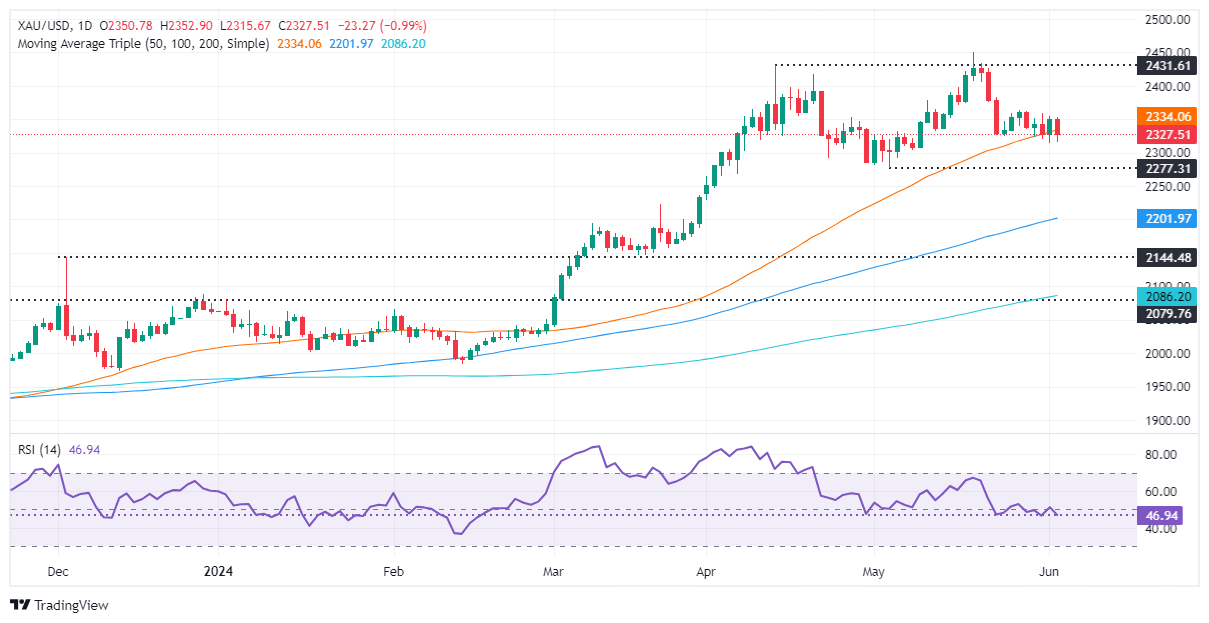- Gold drops 0.90% as commodities face widespread pressure.
- US Treasury yields fall seven basis points, but the Greenback gains marginally, with the DXY up 0.04% to 104.08.
- US JOLTS data hit three-year low, showing economic slowdown alongside below-estimate Durable Goods Orders.
Gold prices retreat some 0.90% in the mid-North American session on Tuesday, amid a risk-off impulse and despite falling US Treasury bond yields. The latest tranche of US economic data shows the economy is slowing down, warranting lower interest rates. Despite that, the XAU/USD trades with losses and exchanges hands at $2,328.
The golden metal has fallen below $2,350 a troy ounce as commodities plunges across the board. Oil prices were under heavy pressure earlier amidst fears that the global economy might grow at a slower pace, which could dent demand for crude.
US Treasury yields, which usually correlate inversely to Gold prices, were also down seven basis points by the US 10-year Treasury yield.
In opposition, the Greenback is trading with marginal gains of 0.04% in the US Dollar Index (DXY). The DXY tracks the Greenback against a basket of six currencies and is up at 104.08.
Data-wise, the US economic docket featured the release of April’s JOLTS data and Durable Goods Orders. The reports showcased that the economy remains resilient yet weak amid higher borrowing costs set by the US Federal Reserve (Fed).
Following the data release, the December 2024 fed funds rate futures contract showed that most traders expect at least 36 basis points of rate cuts via the Chicago Board of Trade (CBOT).
Consequently, US Treasury bond yields dropped, and the Greenback extended its losses to three straight days.
Daily digest market movers: Gold price falls as US Treasury yields retreat
- Tuesday’s US economic docket featured the US JOLTs Job Openings report, which decreased from 8.355 million to 8.059 million in April, falling short of the estimated 8.34 million.
- US Durable Goods Orders rose by 0.6% MoM in April, which is below both the estimates and the previous reading of 0.7%.
- Last week, the US Core Personal Consumption Expenditure Price Index (PCE), the Fed’s preferred inflation gauge, stabilized, boosting hopes for potential rate cuts.
- Meanwhile, business activity showed mixed results, with the S&P Global Manufacturing PMI expanding, while the Institute for Supply Management (ISM) Manufacturing PMI contracted for the second consecutive month.
- Traders are currently pricing about a 54.9% chance of a rate cut, according to the CME FedWatch Tool.
- The US economic docket during the week will feature ADP Employment Change ahead of Friday’s Nonfarm Payrolls.
Technical analysis: Gold price slips below $2,350
Gold’s rally remains in place, though the spot prices have fallen below the 50-day Simple Moving Average (SMA) of $2,334. Price action and the momentum shifting in favor of the sellers could pave the way for a pullback. The Relative Strength Index (RSI) turned bearish, below the 50 midline, opening the door for further Gold losses.
Once the XAU/USD fell below the 50-day Simple Moving Average (SMA) at $2,334, that could pave the way to challenge the May 8 low of $2,303, followed by the May 3 cycle low of $2,277.
Further gains lie ahead if XAU/USD buyers reclaim $2,350. Up next would be the $2,400 level, followed by the year-to-date high of $2,450 and, subsequently, the $2,500 mark.
Gold FAQs
Gold has played a key role in human’s history as it has been widely used as a store of value and medium of exchange. Currently, apart from its shine and usage for jewelry, the precious metal is widely seen as a safe-haven asset, meaning that it is considered a good investment during turbulent times. Gold is also widely seen as a hedge against inflation and against depreciating currencies as it doesn’t rely on any specific issuer or government.
Central banks are the biggest Gold holders. In their aim to support their currencies in turbulent times, central banks tend to diversify their reserves and buy Gold to improve the perceived strength of the economy and the currency. High Gold reserves can be a source of trust for a country’s solvency. Central banks added 1,136 tonnes of Gold worth around $70 billion to their reserves in 2022, according to data from the World Gold Council. This is the highest yearly purchase since records began. Central banks from emerging economies such as China, India and Turkey are quickly increasing their Gold reserves.
Gold has an inverse correlation with the US Dollar and US Treasuries, which are both major reserve and safe-haven assets. When the Dollar depreciates, Gold tends to rise, enabling investors and central banks to diversify their assets in turbulent times. Gold is also inversely correlated with risk assets. A rally in the stock market tends to weaken Gold price, while sell-offs in riskier markets tend to favor the precious metal.
The price can move due to a wide range of factors. Geopolitical instability or fears of a deep recession can quickly make Gold price escalate due to its safe-haven status. As a yield-less asset, Gold tends to rise with lower interest rates, while higher cost of money usually weighs down on the yellow metal. Still, most moves depend on how the US Dollar (USD) behaves as the asset is priced in dollars (XAU/USD). A strong Dollar tends to keep the price of Gold controlled, whereas a weaker Dollar is likely to push Gold prices up.
Information on these pages contains forward-looking statements that involve risks and uncertainties. Markets and instruments profiled on this page are for informational purposes only and should not in any way come across as a recommendation to buy or sell in these assets. You should do your own thorough research before making any investment decisions. FXStreet does not in any way guarantee that this information is free from mistakes, errors, or material misstatements. It also does not guarantee that this information is of a timely nature. Investing in Open Markets involves a great deal of risk, including the loss of all or a portion of your investment, as well as emotional distress. All risks, losses and costs associated with investing, including total loss of principal, are your responsibility. The views and opinions expressed in this article are those of the authors and do not necessarily reflect the official policy or position of FXStreet nor its advertisers. The author will not be held responsible for information that is found at the end of links posted on this page.
If not otherwise explicitly mentioned in the body of the article, at the time of writing, the author has no position in any stock mentioned in this article and no business relationship with any company mentioned. The author has not received compensation for writing this article, other than from FXStreet.
FXStreet and the author do not provide personalized recommendations. The author makes no representations as to the accuracy, completeness, or suitability of this information. FXStreet and the author will not be liable for any errors, omissions or any losses, injuries or damages arising from this information and its display or use. Errors and omissions excepted.
The author and FXStreet are not registered investment advisors and nothing in this article is intended to be investment advice.
Recommended content
Editors’ Picks

AUD/USD: Rebound remains capped at 0.6200 despite gradual US tariff plan
AUD/USD stalls the overnight bounce to near 0.6200 despite reports of gradual Trump tariffs boost investors' sentiment and weigh on the US Dollar. Bets that the Fed will pause its rate-cutting cycle, the RBA's dovish shift, China's economic woes and geopolitical risks act, however, remain a headwind for the Aussie.

USD/JPY volatile within range below 158.00 after BoJ Himino's comments
USD/JPY is seeing a volatile Asian session below 158.00 on Tuesday, courtesy of a dovish commentary from BoJ Deputy Governor Himino as he ruled out a rate hike later this month. However, a negative sentiment on Japanese stocks and a broad US Dollar retreat drag the pair lower.

Gold price regains positive traction amid retreating US bond yields, softer USD
Gold price attracts some dip-buyers during the Asian session on Tuesday and reverses a part of the previous day's retracement slide from a one-month top. Reports that Trump's top economic advisers are mulling a slow ramp-up in tariffs to avoid a sudden spike in inflation trigger a pullback in the US bond yields, which keeps the USD bulls on the defensive and benefits the XAU/USD.

Crypto Today: BTC price plunges 4%, Litecoin X account hacked; traders position for US inflation report
The cryptocurrency sector plunged by 5% on Monday, with over $148 billion wiped off the aggregate market capitalization. Bitcoin price dropped below $90,600 for the first time in 24 days, as traders anticipate the upcoming US CPI report.

Bitcoin falls below $92,000 as exchanges show overheating conditions
Bitcoin (BTC) continues its ongoing correction, falling below $92,000 on Monday after declining almost 4% last week. CryptoQuant data shows that BTC is overheating in exchanges and suggests further decline ahead.

Best Forex Brokers with Low Spreads
VERIFIED Low spreads are crucial for reducing trading costs. Explore top Forex brokers offering competitive spreads and high leverage. Compare options for EUR/USD, GBP/USD, USD/JPY, and Gold.
